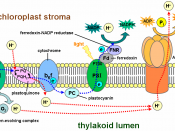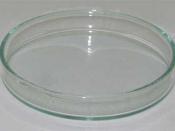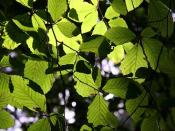Abstract
For this lab the rate of photosynthesis was analyzed upon plant leaves. A sample of a light exposed and a not-light exposed leave were used to clearly identify the role of sunlight in the process of producing and storing energy.
Aim
We are trying to find proof, to demonstrate the necessity of light and chlorophyll in the process of photosynthesis.
Background
Photosynthesis occurs in organisms which contain chlorophyll. It's a process that involves the chloroplasts to synthesize glucose molecules from carbon dioxide and water. Energy (ATP), initially in the form of glucose (monosaccharide) is later formed by condensation reaction into starch (polysaccharide). These alpha-glucose units are attached together by glycosidic bonds. Starch is formed after the Calvin Cycle in the Stroma. Carbon dioxide is present in the air and the water is gained from precipitation or morning dew. The water is broken down in photosystem I (sourcing invisible light of 700nm) by photolysis.
This process sets free electrons and helps close the cycle of the light dependent stage. But before this process can be set off, a gradient in energy must be achieved. The most energy is gained in the first part of the light dependent stage (which creates the gradient) of photosystem II, sourcing in visible light of 680nm.
There are 5 major requirements for photosynthesis to take place: 1) A temperature in the environment between 5 - 35 degree Celsius, 2) Chlorophyll available in chloroplasts, 3) Water, 4) Carbon dioxide and 5) Light of favorable intensity. If any of these factors are absent, photosynthesis cannot occur.
Materials required
Materials list
Geranium, begonia, or impatiens plants (entirely green leaves), coleus with variegated leaves (green and white colored), hot plates and hot-water bath, Lugol's iodine solution in dropper bottles, 250-mL beakers, 100-mL beakers, tongs, foreceps, Petri dishes, glass-marking...


